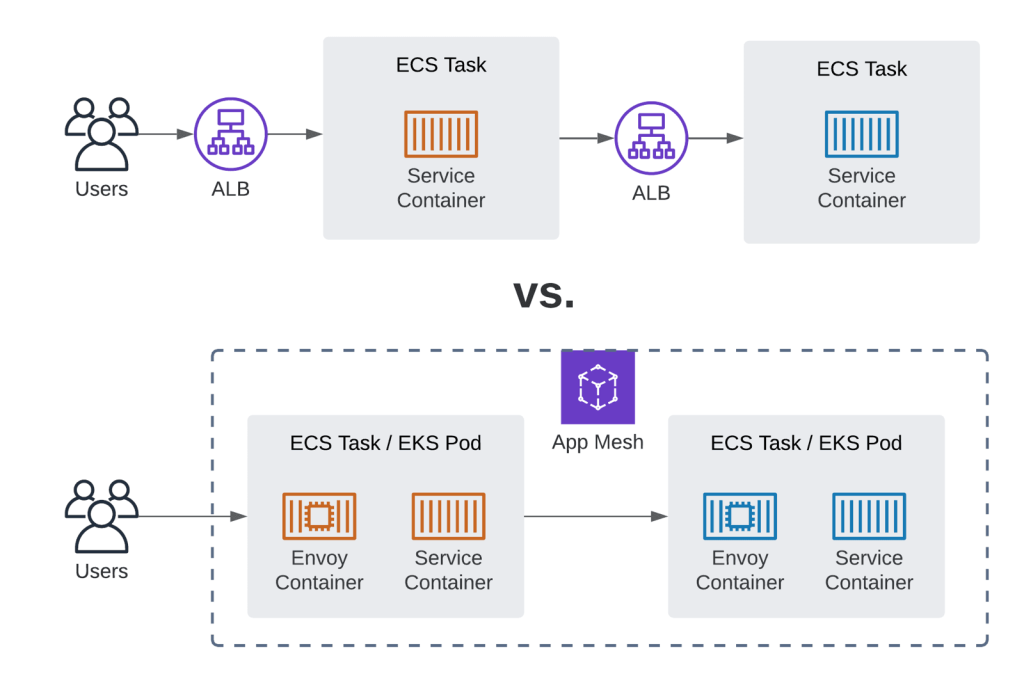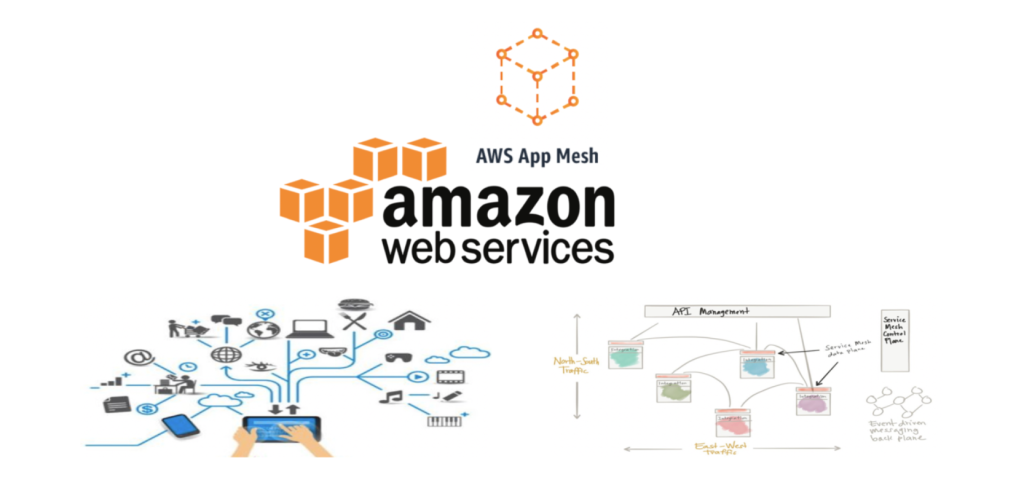What is AWS App Mesh?

AWS App Mesh is a service mesh offering from Amazon Web Services that facilitates communication and management of your microservices across multiple types of compute infrastructure. It provides a layer of abstraction over the underlying network, simplifying tasks like:
- Traffic routing: Control how requests flow between your services based on rules and routing configurations.
- Service discovery: Enable services to find each other dynamically for seamless communication.
- Traffic management: Implement features like load balancing, retries, and circuit breakers for resilience and performance.
- Security: Enforce encryption, authentication, and authorization policies to protect your services.
- Observability: Collect metrics and tracing data to gain insights into service behavior and troubleshoot issues.
Top 10 use cases of AWS App Mesh?
Top 10 Use Cases of AWS App Mesh:
- Modernize monoliths: Gradually decompose monoliths into microservices while ensuring smooth communication and management.
- Simplify service communication: Replace complex service-to-service communication logic with a standardized approach.
- Improve service resiliency: Implement features like retries and circuit breakers to handle failures gracefully.
- Enforce security policies: Control access to your services and encrypt communication channels for enhanced security.
- Gain observability: Collect detailed metrics and traces for performance monitoring and troubleshooting.
- Enable A/B testing and canary deployments: Safely test new service versions with controlled traffic routing.
- Scale applications efficiently: Distribute traffic across multiple instances of your services for improved scalability.
- Manage workloads across platforms: Use App Mesh with various AWS compute services like EC2, EKS, and Fargate.
- Integrate with existing tools: Leverage integrations with other AWS services and popular monitoring tools.
- Simplify CI/CD workflows: Automate service mesh configuration and deployments.
Key Benefits of Using AWS App Mesh:
- Reduced Operational Complexity: Simplifies managing communication and security for your microservices.
- Improved Application Performance: Enhances the efficiency and resilience of your services.
- Enhanced Security: Provides built-in security features to protect your applications.
- Scalability and Flexibility: Scales seamlessly with your growing application needs.
- Integration with AWS Ecosystem: Integrates seamlessly with other AWS services and tools.
Remember, these are just a few examples, and the specific use cases will vary depending on your application architecture and needs. However, if you’re building or managing microservices on AWS, App Mesh is a powerful tool to consider for streamlining communication, security, and overall application health.
What are the feature of AWS App Mesh?
AWS App Mesh boasts a range of features designed to simplify and secure microservice communication within your applications. Following is a breakdown of some key functionalities:
Traffic Management:
- Routing: Define rules for directing traffic based on paths, headers, and other attributes.
- Service Discovery: Enable services to automatically discover each other for dynamic communication.
- Load Balancing: Distribute traffic efficiently across healthy service instances for optimal performance.
- Traffic Splitting: Implement A/B testing and canary deployments by gradually rolling out new versions to a portion of traffic.
- Retries and Timeouts: Handle failures gracefully by retrying requests or routing them to healthy instances.
- Circuit Breakers: Prevent service overload by limiting requests and gracefully failing requests when necessary.
Security:
- Mutual TLS (mTLS): Enforce encryption for communication between services for data security.
- Authentication and Authorization: Control access to services using IAM roles and policies.
- Service Identity and Access Management: Utilize AWS IAM for granular access control to App Mesh resources.
Observability:
- Metrics and Tracing: Collect detailed metrics and distributed tracing data for service performance monitoring and troubleshooting.
- Integration with CloudWatch: Leverage CloudWatch for centralized logging, monitoring, and analysis of App Mesh data.
Additional Features:
- Virtual Nodes and Endpoints: Abstract service infrastructure details and manage communication through logical constructs.
- Virtual Gateways: Define entry and exit points for traffic flow into and out of your mesh.
- Mesh Configuration and Updates: Manage App Mesh configuration declaratively using YAML files or AWS CLI commands.
- Integration with CI/CD pipelines: Automate App Mesh deployments and configuration management within your development workflow.
- Support for Multiple Platforms: Works with various AWS compute services like EC2, EKS, and Fargate.
The specific features you utilize will depend on your specific needs and the version of App Mesh you’re using. This overview provides a good starting point for understanding the wide range of capabilities offered by App Mesh to manage and secure your microservice communication infrastructure on AWS.
How AWS App Mesh works and Architecture?

AWS App Mesh works with a two-plane architecture, separating the data plane and control plane for efficient management and operation:
Data Plane:
- Envoy Proxy: Deployed alongside each microservice, acting as a sidecar proxy.
- Virtual Nodes and Endpoints: Represent services and their network endpoints logically.
- Traffic Routing: Envoys route traffic based on App Mesh configuration, using features like load balancing and retries.
- Data Collection: Envoys collect metrics and traces for observability.
Control Plane:
- App Mesh Service: Hosted by AWS, manages configuration and state of the data plane.
- Mesh Definition: YAML configuration defining services, virtual nodes, routes, and policies.
- XDS API: Exposes an API for managing Envoy configuration dynamically.
Interaction and Flow:
- Client sends a request to the mesh gateway (if applicable).
- The gateway routes the request to the appropriate virtual node based on routing rules.
- Envoy in the target virtual node intercepts the request and applies policies like authentication and authorization.
- Envoy forwards the request to the actual service instance associated with the virtual node.
- The service processes the request and sends a response back to Envoy.
- Envoy applies any necessary transformations and sends the response back to the client (potentially via the gateway).
Key Architectural Concepts:
- Decoupled Data Plane and Control Plane: Improves scalability, manageability, and flexibility.
- Sidecar Envoy Proxy: Provides granular control and data collection at the service level.
- Declarative Configuration: Simplifies management with human-readable YAML files.
- XDS API: Enables dynamic configuration updates for Envoys.
- Integration with AWS Ecosystem: Leverages other AWS services for security, monitoring, and logging.
Understanding this architecture will give you a solid foundation for appreciating how AWS App Mesh simplifies and secures service communication in your microservice applications.
How to Install AWS App Mesh it?
As AWS App Mesh is a managed service offered by Amazon Web Services, there’s no direct installation process like with traditional software. Instead, you configure and utilize it within your AWS environment. Let’s have look at a breakdown of the steps involved:
1. Create an AWS Account and Set Up IAM:
- If you don’t already have an AWS account, create one from their amazon site.
- Ensure you have appropriate IAM permissions to manage App Mesh resources. Consider creating specific IAM roles for different tasks like creating meshes and managing traffic routing.
2. Create an App Mesh Mesh:
- Navigate to the AWS App Mesh console.
- Click on “Create mesh” and provide a name and description for your mesh.
- Choose the AWS account and region where you want to create the mesh.
- Configure additional settings like tracing and access logging as needed.
3. Add Services to Your Mesh:
- Define the services within your application that will communicate through App Mesh.
- You can choose services running on various AWS compute platforms like EC2, EKS, or Fargate.
- For each service, create a virtual service and virtual node in App Mesh.
- The virtual service defines routing rules and policies, while the virtual node represents the service instance logically.
4. Configure Traffic Routing:
- Define how you want traffic to flow between your services using routing rules.
- You can base routing on paths, headers, methods, or other attributes.
- Utilize features like path rewriting, weight-based load balancing, and service discovery for dynamic routing.
5. Implement Security Policies:
- Enforce authentication and authorization policies to control access to your services.
- You can leverage AWS IAM roles and policies for granular access control.
- Consider using mutual TLS (mTLS) encryption for secure communication between services.
6. Monitor and Manage Your Mesh:
- Use the App Mesh console or AWS CLI to monitor metrics and trace data for your services.
- Troubleshoot issues and identify bottlenecks for performance optimization.
- Integrate App Mesh with other AWS services like CloudWatch for centralized logging and monitoring.
The specific configuration steps may vary depending on your application architecture and needs. The resources provided above offer detailed guidance and examples to help you get started with AWS App Mesh and manage your microservice communication effectively.
Basic Tutorials of AWS App Mesh: Getting Started

AWS App Mesh simplifies managing service-to-service communication in your applications running on AWS infrastructure. Here are some step-by-step tutorials to get you started:
Prerequisites:
- An AWS account and basic understanding of AWS services.
- Familiarity with Docker or Kubernetes depending on your deployment method.
1. Choose a deployment method:
- AWS Management Console: Easiest but limited to simple deployments.
- AWS CLI: Offers more flexibility and scripting options.
- AWS CDK: Infrastructure as code approach for automation and collaboration.
2. Create a mesh:
Follow the chosen method’s guide to create a mesh. Here’s an example using the AWS Management Console:
- Go to the AWS App Mesh service console.
- Click “Create mesh”.
- Enter a name for your mesh (e.g., “my-app-mesh”).
- Optionally, configure access control settings.
- Click “Create mesh”.
3. Create a virtual service:
This defines how requests are routed within your mesh:
- Go to the “Virtual services” tab.
- Click “Create virtual service”.
- Enter a name for your service (e.g., “my-api”).
- Select the HTTP or gRPC protocol used by your service.
- Click “Create”.
4. Create a virtual node:
This represents an instance of your service:
- Go to the “Virtual nodes” tab.
- Click “Create virtual node”.
- Enter a name for your node (e.g., “my-api-v1”).
- Select the service your node belongs to.
- Specify how to discover your service instances (e.g., DNS name).
- Click “Create”.
5. Create a route:
This defines how traffic flows within your mesh:
- Go to the “Routes” tab.
- Click “Create route”.
- Select the virtual service to route traffic for.
- Specify the port and path to match incoming requests.
- Choose the virtual node to direct traffic to.
- (Optional) Configure advanced routing rules like weighting or timeouts.
- Click “Create”.
6. Deploy your services:
- Docker: Inject the App Mesh Envoy sidecar proxy into your container image.
- Kubernetes: Deploy your service with the App Mesh controller managing the sidecar injection.
7. Test your deployment:
Send requests to your service endpoint and observe traffic flowing through the mesh using the App Mesh console or metrics integration.
Advanced Tutorials:
- Service discovery with service registry integration.
- Traffic splitting and A/B testing.
- Authentication and authorization with AWS IAM.
- Observability with tracing and metrics.
Note:
- These tutorials provide a basic introduction to AWS App Mesh.
- Choose the deployment method and configuration options that best suit your needs and environment.
- Secure your mesh with proper authentication and authorization controls.
By following these step-by-step tutorials and exploring the resources provided, you can leverage AWS App Mesh to manage and secure service communication in your cloud applications.
- PPG Industries: Selection and Interview process, Questions/Answers - April 3, 2024
- Fiserv: Selection and Interview process, Questions/Answers - April 3, 2024
- Estee Lauder: Selection and Interview process, Questions/Answers - April 3, 2024

